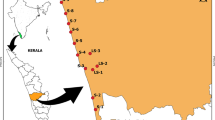Abstract
In this study, ultra-performance liquid chromatography coupled with a quadruple time-of-flight mass spectrometry (UPLC-Q-ToF-MS) was employed to screen and identify pharmaceutical pollutants and emerging contaminants (ECs) in the Periyar River near Aster Medicity hospital, the dumping yard of Amrutha hospital, and the Vaduthala bridge regions in Kerala, India. The analysis was conducted in both positive and negative ionization modes using electrospray ionization (ESI). The QuEChERS method was employed for initial sediment sample preparation. Among the twenty-five identified ECs, four compounds were identified as pharmaceutical pollutants. This study have great significance as it represents the first comprehensive investigation of pharmaceutical pollutants in these hospital regions, highlighting the urgent need for further analysis and understanding of the situation. The presence of ECs poses an urgent need for attention due to the irreversible harm caused to the riverine ecosystem by the degradation of water quality resulting from industrial and domestic discharge.

Similar content being viewed by others
References
American Public Health Association, American Water Works Association, Water Pollution Control Federation, & Water Environment Federation. (1912). Standard methods for the examination of water and wastewater (Vol. 2). American Public Health Association
EFSA Panel on Additives, Products or Substances used in Animal Feed (FEEDAP), Bampidis V, Azimonti G, Bastos MDL, Christensen H, Dusemund B, Innocenti M (2022) Safety and efficacy of a feed additive consisting of ethoxyquin (6-ethoxy‐1, 2‐dihydro‐2, 2, 4‐trimethylquinoline) for all animal species (FEFANA asbl). EFSA Journal, 20(3), e07166
Egloff S, Pietsch C (2018) Ethoxyquin: a feed additive that poses a risk for aquatic life. Dis Aquat Organ 131(1):39–48
Gupta SD, Rao GB, Bommaka MK, Raghavendra NM, Aleti S (2016) Eco-sustainable synthesis and biological evaluation of 2-phenyl 1, 3-benzodioxole derivatives as anticancer, DNA binding, and antibacterial agents. Arab J Chem 9:S1875–S1883
Hernandez F, Sancho JV, Ibáñez M, Abad E, Portolés T, Mattioli L (2012) Current use of high-resolution mass spectrometry in the environmental sciences. Anal Bioanal Chem 403(5):1251–1264
Khalid NK, Devadasan D, Aravind UK, Aravindakumar CT (2018) Screening and quantification of emerging contaminants in Periyar River, Kerala (India) by using high-resolution mass spectrometry (LC-Q-ToF-MS). Environ Monit Assess 190(6):1–12
Mathieu-Denoncourt J, Martyniuk CJ, de Solla SR, Balakrishnan VK, Langlois VS (2014) Sediment contaminated with the azo dye disperse yellow 7 alters cellular stress-and androgen-related transcription in Silurana tropicalis larvae. Environ Sci Technol 48(5):2952–2961
Perovani IS, de Oliveira ARM (2018) Determination of Ethofumesate-2‐hydroxy stereolability by dynamic HPLC. Sep Sci Plus 1(12):771–775
Perovani IS, Carrao DB, de Albuquerque NCP, de Oliveira ARM (2020) Enantioselective in vitro metabolism and in vitro-in vivo correlation of the herbicide ethofumesate in a human model. J Pharm Biomed Anal 187:113349
Schenck FJ, Hobbs JE (2004) Evaluation of the quick, easy, cheap, effective, rugged, and safe (QuEChERS) approach to pesticide residue analysis. Bull Environ Contam Toxicol 73(1):24–30
Sreelakshmi CD, Chinnamma MA (2018) Quality Assessment of Sediments in Bharathapuzha with Special reference to phosphate fractionation and metallic contamination. Int J Adv Info Eng Technol, 5(4)
Tomy T, Joseph J (2022) “quality assessment of water in rivers of central Kerala (India) with special reference to mercuric contamination during monsoon season” International Journal of Engineering Sciences & Research Technology Vol. 11 Issue 7- July 2022
Vasileiadis S, Puglisi E, Papadopoulou ES, Pertile G, Suciu N, Pappolla RA, Karpouzas DG (2018) Blame it on the metabolite: 3, 5-dichloroaniline rather than the parent compound is responsible for the decreasing diversity and function of soil microorganisms. Appl Environ Microbiol 84(22):e01536–e01518
Xu R, Wu J, Liu Y, Zhao R, Chen B, Yang M, Chen J (2011) Analysis of pesticide residues using the quick easy cheap effective rugged and safe (QuEChERS) pesticide multiresidue method in traditional chinese medicine by gas chromatography with electron capture detection. Chemosphere 84(7):908–912
Xu CS, Zhou Y, Jiang Z, Wang LE, Huang JJ, Zhang TY, Zang LL (2019) The in vitro effects of gibberellin on human sperm motility. Aging 11(10):3080
Yang J, Geng Q, Zhou Y, Wang Y, Li Z, Liu Y (2022) Optimization of experimental procedure for determining azelaic acid in cosmetics by gas chromatography derivatized through ethanol. ACS Omega 7(18):15647–15656. *https://pubchem.ncbi.nlm.nih.gov **https://www.chemicalbook.com/ChemicalProductProperty_EN_CB2761158.htm ***https://www.sigmaaldrich.com/IN/en/product/aldrich/454648
Acknowledgements
The authors acknowledge with gratitude to the Mahatma Gandhi University Kottayam for the Junior Research Fellowship and the Directorate of Collegiate Education, Government of Kerala for an internship to carry out the research work. Special thanks are extended to Dr. Mahesh Mohan, Assistant Professor at the School of Environmental Sciences, for his valuable guidance during the internship. The authors also express their gratitude to the Inter-University Instrumentation Centre and Dr. C. T. Aravindakumar, Professor and Director of Inter-University Instrumentation Centre School of Environmental Sciences Mahatma Gandhi University Kottayam for providing the UPLC-Q-ToF-MS facility. Additionally, the authors acknowledge to Mr. Naveen Babu Research Scholar of the School of Environmental Science at Mahatma Gandhi University Kottayam who produced the map of the study area.
Author information
Authors and Affiliations
Corresponding author
Ethics declarations
Conflict of interest
The authors declare that there is not any conflict of interest regarding the publication of this manuscript.
Life Science Reporting
No life science threat was practiced in this research.
Additional information
Publisher’s Note
Springer Nature remains neutral with regard to jurisdictional claims in published maps and institutional affiliations.
Rights and permissions
Springer Nature or its licensor (e.g. a society or other partner) holds exclusive rights to this article under a publishing agreement with the author(s) or other rightsholder(s); author self-archiving of the accepted manuscript version of this article is solely governed by the terms of such publishing agreement and applicable law.
About this article
Cite this article
Tomy, T., Jameson, J. Screening of Pharmaceutical Pollutants Along with Emerging Contaminants in the Sediments of the Periyar River, Located in Kerala (India) by Using High-Resolution Mass Spectrometry (UPLC-Q-ToF-MS). Bull Environ Contam Toxicol 111, 31 (2023). https://doi.org/10.1007/s00128-023-03791-9
Received:
Accepted:
Published:
DOI: https://doi.org/10.1007/s00128-023-03791-9




